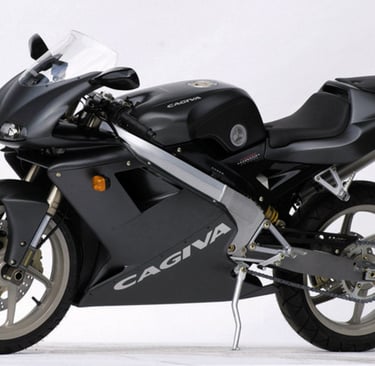Cagiva Motorcycles: The Italian Legacy in Two-Wheeled Mastery
Cagiva Motorcycles, an Italian manufacturer with a history of over seven decades, has made a significant impact in the world of motorcycles. Founded in 1950, Cagiva started by producing small metal components and later entered the motorcycle industry in 1978. They gained recognition for their racing triumphs and innovation, especially after acquiring Ducati in 1985. Cagiva also underwent strategic expansions and restructuring, acquiring brands like Moto Morini and Husqvarna. Despite facing industry changes and environmental considerations, Cagiva has maintained its racing legacy, with achievements in Grand Prix and the Dakar Rally. Their product lineup has included diverse models catering to different types of riders, and they have also crafted elegant mopeds and scooters. Cagiva's rich heritage as an Italian motorcycle brand continues to endure, and the Castiglioni family's reunion with the brand in 2010 reflects their enduring passion for motorcycles.
TWO STROKECAGIVA ITALY 1970'SMOTORCYCLES
11/19/20233 min read


Cagiva Motorcycles: The Italian Legacy in Two-Wheeled Mastery
Cagiva, the Italian motorcycle manufacturer with a history spanning over seven decades, has left an indelible mark on the world of two-wheeled wonders. Founded in 1950 by Giovanni Castiglioni in Varese, Cagiva began its journey crafting small metal components before transitioning into the motorcycle industry in 1978 under the leadership of Giovanni's sons, Claudio and Gianfranco Castiglioni.
Racing Triumphs and Innovation
Cagiva's prowess extends beyond the sleek aesthetics of its machines; the company has an illustrious racing history. In 1978, Cagiva made a bold entry into motorcycle racing, acquiring a factory in Varese and rapidly expanding its production. The early models, powered by two-stroke engines ranging from 125 cc to 350 cc, quickly gained recognition, with the annual production soaring to 40,000 motorcycles by 1979.
The strategic acquisition of Ducati in 1985 marked a turning point for Cagiva, introducing four-stroke v-twin engines and venturing into the big displacement market. The marriage of Ducati's engineering excellence and Cagiva's innovation resulted in iconic models like the Cagiva Ala Azzurra and Elefant.
Strategic Expansions and Restructuring
Cagiva's growth trajectory included key acquisitions such as Moto Morini and Husqvarna in 1987, followed by the trademarks for the MV Agusta brand in 1991. However, recognizing the winds of change, Cagiva underwent restructuring in 1999, with MV Agusta emerging as the parent company. This strategic shift aimed at concentrating resources and reinforcing MV Agusta as the primary brand identity.
The early 2000s witnessed the end of certain Cagiva models, including the iconic Cagiva Roadster, as the company navigated industry changes and environmental considerations. In 2008, Harley-Davidson briefly entered the picture by acquiring MV Agusta Motor, Cagiva's parent company. However, by 2010, Cagiva found its way back into the hands of the Castiglioni family, underscoring the resilience and commitment to the brand's heritage.
Racing Glory: Grand Prix and Dakar Rally
Cagiva's foray into Grand Prix motorcycle racing in the late 1970s marked the beginning of a legacy. Lead rider Randy Mamola achieved Cagiva's first podium result, and the company continued to make strides with Eddie Lawson securing victory in the 1992 Hungarian Grand Prix. The 500cc World Championship witnessed John Kocinski finishing third in the 1994 championship, further solidifying Cagiva's racing prowess.
The Dakar Rally, a grueling off-road challenge, became another arena for Cagiva's triumphs. Italian rider Edi Orioli clinched victory in 1990 and 1994 aboard the Ducati-powered Cagiva Elefant, showcasing the brand's versatility across diverse terrains.
Diverse Models for Every Enthusiast
Cagiva's product lineup has been as diverse as the landscapes its motorcycles have conquered. From the nimble two-stroke models like the Mito series, known for launching the career of legendary rider Valentino Rossi, to the off-road enduro and trial bikes like the WMX and Elefant series, Cagiva catered to a spectrum of riders.
The road-focused models included classics like the Alazzurra and the innovative W16, featured in the pre-title sequence of the James Bond film "GoldenEye."
Moped and Scooter Elegance
Cagiva's commitment to crafting accessible and stylish rides is evident in its moped and scooter offerings. The Cocis, Prima, SuperCity, Mito 50, and W4 series showcased Cagiva's dedication to blending performance with urban convenience.
Legacy and Beyond
As Cagiva entered the 21st century, its legacy endured, though production of certain high-engine-capacity models concluded in 2012. The brand, with its rich heritage, remains a symbol of Italian motorcycling excellence. Whether conquering racetracks, challenging off-road terrains, or navigating city streets, Cagiva motorcycles embody the spirit of riders seeking a perfect blend of performance and style. The Castiglioni family's reunion with the brand in 2010 echoes the enduring passion that fuels Cagiva, ensuring that the iconic motorcycles continue to roar on roads around the world.
